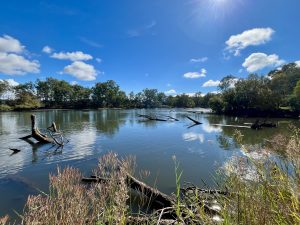The mission of Parklands Albury Wodonga is to restore and improve the bush parks that we are so lucky to have on our doorstep, with the goal of increasing their levels of biodiversity. For the past five years, Parklands has been undertaking a series of conservation works in Baranduda Regional Park, with our Bush for Birds project. This project has involved weed control as well as revegetation with the main focus being to address the key threatening processes for regent honeyeaters, however, other woodland birds and native mammals will also benefit.
The regent honeyeater (Anthochaera phrygia) has been a flagship species for biodiversity conservation after becoming listed as critically endangered over much of its range. With population numbers rapidly declining over the past 30 years, efforts to bring this species back from the brink of extinction have been undertaken across New South Wales and in Victoria, with the goal of achieving a self-sustaining wild population through habitat restoration and release of captive-bred birds. Currently there are only four main breeding areas remaining, including the box-ironbark forests in the area near Chiltern, as well as three sites in NSW.
Factors contributing to the decline in regent honeyeater numbers include habitat loss due to clearing of woodland and dieback of mature trees in response to extreme climate. Regent honeyeaters are also a species at risk from harvesting of box and ironbark for firewood. In addition, competition from other species where they feed and nest are affecting regent honeyeater numbers. Noisy miners (Manorina melanocephala) in particular are more aggressive and can displace regent honeyeaters as well as other woodland birds, and nest predation by native predators such as pied currawongs (Strepera graculina) is also a threat.
The Bush for Birds project has focused on three main objectives relating to threats to regent honeyeaters across 104 hectares of the park:
- Weed control to remove/reduce invasive species by either spraying or cutting and poisoning.
- Revegetation with plantings of several different species.
- Control of population numbers of noisy miners.
This has been a massive effort, sometimes in difficult terrain, with several invasive species targeted including tree-of-heaven (Ailanthus altissima), wild fig (Ficus carica), sweet briar rose (Rosa rubiginosa), privet (Ligustrum vulgare), prunus (Prunus domestica), purple top (Verbena bonariensis), and blackberry (Rubus fruticosis).
The photos below (taken at the same location) show an example of the progress in eradication of blackberries.



Stands of tree-of-heaven were targeted and larger trees such as this fig were poisoned with good results.



Numbers of kurrajong (Brachychiton populeneus), white box (Eucalyptus albens), Blakely’s red gum (Eucalyptus blakelyi), yellow box (Eucalyptus melliodora), mugga ironbark (Eucalyptus sideroxylon), blackwood (Acacia melanoxylon), long leaf box (Eucalyptus bridgesiana), and red box (Eucalyptus polyanthemos) seedlings were planted over the winter months of 2020 – 2023. These were sourced from a hotter, drier provenance in response to a changing climate and will grow to a range of sizes with flowering spread over most of the year. This mixture of species will increase the supply of nectar, insects, and seeds in the environment and will provide food and habitat not only for regent honeyeaters but also for the swift parrot (Lathamus discolor; listed as critically endangered in Victoria) and other woodland birds. In all, 800 seedlings were planted, with 40% being mugga ironbark, as this is a favourite of regent honeyeaters. Special deer- and kangaroo-proof guards were used around the seedlings to increase planting success.




Projects like these add natural value to our regional parks and will continue to improve the landscape for generations to come. It is important that we act now to conserve these places, especially as habitat for many of our native animals is in decline.
This project was made possible with funding from North East Catchment Management Authority and the Australian Government.






